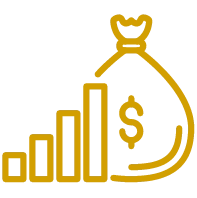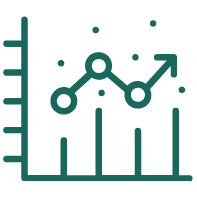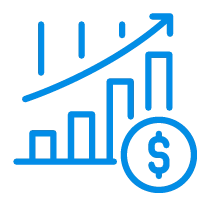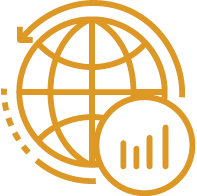List of Contents
What is Stem Cells Market Size?
The global stem cells market size is exhibited at USD 18.65 billion in 2025 and is projected to grow from USD 20.79 billion in 2026 to approximately USD 48.83 billion by 2034, and growth rate CAGR of 11.30% from 2025 to 2034.
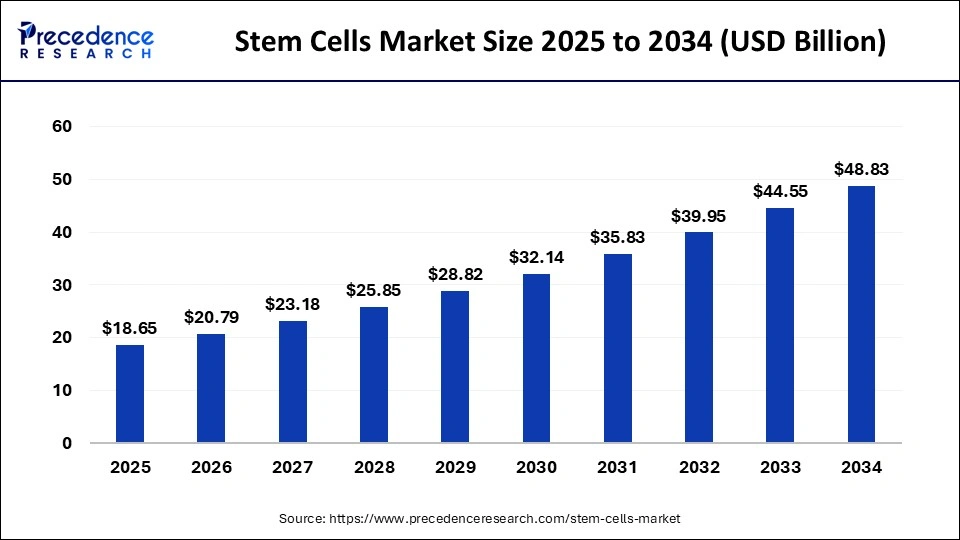
Market Highlights
- North America held a market share of 44% in 2024.
- Asia Pacific region is estimated to grow at a solid CAGR during the forecast period.
- By application, the oncology segment registered the maximum market share in 2024.
- By product, the stem cell segment has held the largest market share in 2024.
- By technology, the cell acquisition technology segment captured the biggest revenue share in 2024.
- By therapy, the allogeneic segment is estimated to hold the highest market share of 60% in 2024.
Market Overview
Global stem cells have acquired noteworthy attention from the multi-sectored community of scientists. Growing investment in stem cells research and the exponential success of regenerative medicines are projected to propel the market growth. Another growth rendering factor for the global stem cells market is increasing number of clinical trials across the globe. Stem cell technology has garner importance over the last few years as it is used to treat the diseased organs, damaged tissues and regenerative medicines. Increasing number of stem cells banking and government initiatives drives the growth of the stem cells market in emerging countries.Additionally, growing awareness among regarding storage of stem cells has positively impacted the market propagation. However, growing awareness about alternative procedures is likely to hinder the market growth. Nonetheless, growing stem cell-based research and investment by pharmaceutical and biopharmaceutical companies will significantly propel the market growth over the forecast period.
Market Outlook
- Industry Outlook: Industry dynamics are characterized by intense innovation, regulatory complexity, and scaling challenges. Large biopharma firms are partnering with or acquiring cell-therapy specialists to integrate platforms into broader portfolios; CDMOs focused on GMP cell manufacturing are becoming critical infrastructure for commercialization. Standardization of potency assays, scalable bioreactors, closed-system processing and cryostorage logistics will determine which therapies scale successfully.
- Sustainability Trend:Sustainability in the stem-cell ecosystem focuses on minimizing environmental footprint of manufacturing and maximizing long-term healthcare value. Efforts include reducing single-use plastic waste in GMP suites through recyclable or more efficient single-use systems, optimizing energy use in cryostorage more efficient freezers, alternatives to liquid nitrogen consumption, and improving supply-chain localization to reduce transport emissions for temperature-sensitive materials. Clinically, sustainable impact is measured in improved patient outcomes and reduced lifetime treatment burden.
- Major Investment: Investment is concentrated in scalable manufacturing (GMP-grade automated bioreactors, closed-system cell-processing lines), vector and cell-engineering platforms, analytics for potency and identity, cold-chain logistics and cryobanking infrastructure, and late-stage clinical trials that demonstrate definitive outcomes. Investors also fund CDMOs specializing in cell therapies, companies developing off-the-shelf allogeneic products, and platform technologies that simplify cell manipulation (microfluidic sorters, automated expansion systems).
- Start-ups Ecosystem: Start-ups are prolific and diverse: gene-edited stem-cell platforms for safe universal donor products; MSC-based immunomodulatory therapies; iPSC-derived cell products for retinal, cardiac and neurodegenerative indications; cell-sheet and tissue-engineering firms building implantable constructs; microphysiological systems for preclinical testing; and automation companies building closed, scalable manufacturing suites.
Market Scope
| Report Highlights | Details |
| Market Size by 2025 | USD 18.65 Billion |
| Market Size in 2026 | USD 20.79 Billion |
| Market Size in 2034 | USD 48.83 Billion |
| Market Growth Rate from 2025 to 2034 | CAGR of 11.30% |
| Fastest Growing Market | Asia Pacific |
| Base Year | 2024 |
| Forecast Region | 2025 to 2034 |
| Segments Covered | Product, Application, Technology, Therapy and Region |
| Regions Covered | North America, APAC, Europe, Latin America, MEAN, Rest of the World |
Market Dynamics
Drivers
Rising application in research and therapies
Stem cell products are widely used in various applications that include research and therapies such as medicines. Rising demand for regenerative medicines is one of the major factors proliferating the growth of the market. Increasing popularity for stell cells among researchers and clinicians to develop regenerative medicines is also triggering the potential demand in the industry. In July 2022, Bio Techno, which manufactures develops, and sells science reagents acquired Namocell, a US-based company that deals in providing instruments and consumables required for gene therapy.
Business activities in the industry
Stem cell products are increasingly becoming popular in pharmaceutical companies. The rising need for effective stem cell therapies for neurological disorders is leading to a surge in research and development activities in the market. Growing collaborative activities between pharmaceutical and biotechnological companies is triggering the growth of the industry. For example, In July 2023, Pluristyx partnered with Stem Genomics. Through the collaboration, the businesses will provide a standardized method for users to access the genomic stability of Pluristyx's pluripotent stem cell (PSC) lines using the ICS-digital PSC test from Stem Genomics.
Restraints
Ethical and regulatory issues
The stem cell market has proven effective in the treatment of new diseases such as diabetes, and spinal cord injury. However, some countries and regions have put restrictions on certain stell cell research which is further limiting the growth of the market. Human embryonic stem cell research involves damaging human embryos to create cell lines. Furthermore, the risks associated with stem cell plantation include unsuitable mitigation of stem cells.
High cost of treatment
The high cost associated with stem cells is observed to limit the growth of the market. Stem treatment has come as an effective option in treating various chronic diseases. Developing stem cell-based therapies is also costly and time-consuming. The research and development process, as well as the need for clinical trials and regulatory approvals, require significant financial investments.
Opportunity
Rising demand for regenerative medicines
The demand for regenerative medicines is experiencing major popularity. Stell cells hold great potential for regenerating damaged or diseased tissues and organs. The therapies assist in treating various diseases including heart disease, and diabetes. Advancements in stem cell research also enable the development of personalized treatments based on a patient's stem cells, reducing the risk of rejection and improving treatment outcomes.
Segment Insights
Application Insights
The oncology segments exhibited the highest growth rate owing to the existence of various pipeline products for the treatment of cancer and tumors. Increasing regenerative medicine centers are expected to increase the prospects for stem cells in the near future.
Product Insights
The global stem cell market is classified into adult stem cell, human embryonic stem cells, very small embryonic like stem cell, and induced pluripotent stem cell.
Among these, adult stem cells dominated the global market in 2024 and is expected to hold the dominance over the forecast period owing to less contamination risk integrated with sub-culturing, less need of production labor and compatibility with the human body.
Technology Insights
Amidst different technology segments, the cell acquisition technology dominated the stem cells market in 2024. Increasing awareness about the exponential significance of stem cells has propel to noteworthy growth in cell harvesting, which resulting in growth in the global stem cells market. Generally, the most common method used in order to cell acquisition is the bone marrow harvest as the tissues recovery from bone marrow stem cells is relatively faster.
Therapy Insights
The allogeneic segment is estimated to hold the highest market share of 60% in 2024. The benefit of allogeneic stem cell is that the donor stem cells male their own immune cells which can help destroy cancer cells that may remain after high-dose treatment. This graft-versus-cancer is used in prevention of cancer relapse. The incidences of cancer relapse increasing significantly, generally it takes place within 1 year after therapy and these happenings are noticed in children and people suffering from oropharyngeal and breast cancer These facts are in turn accelerating growth of allergic therapies segment.
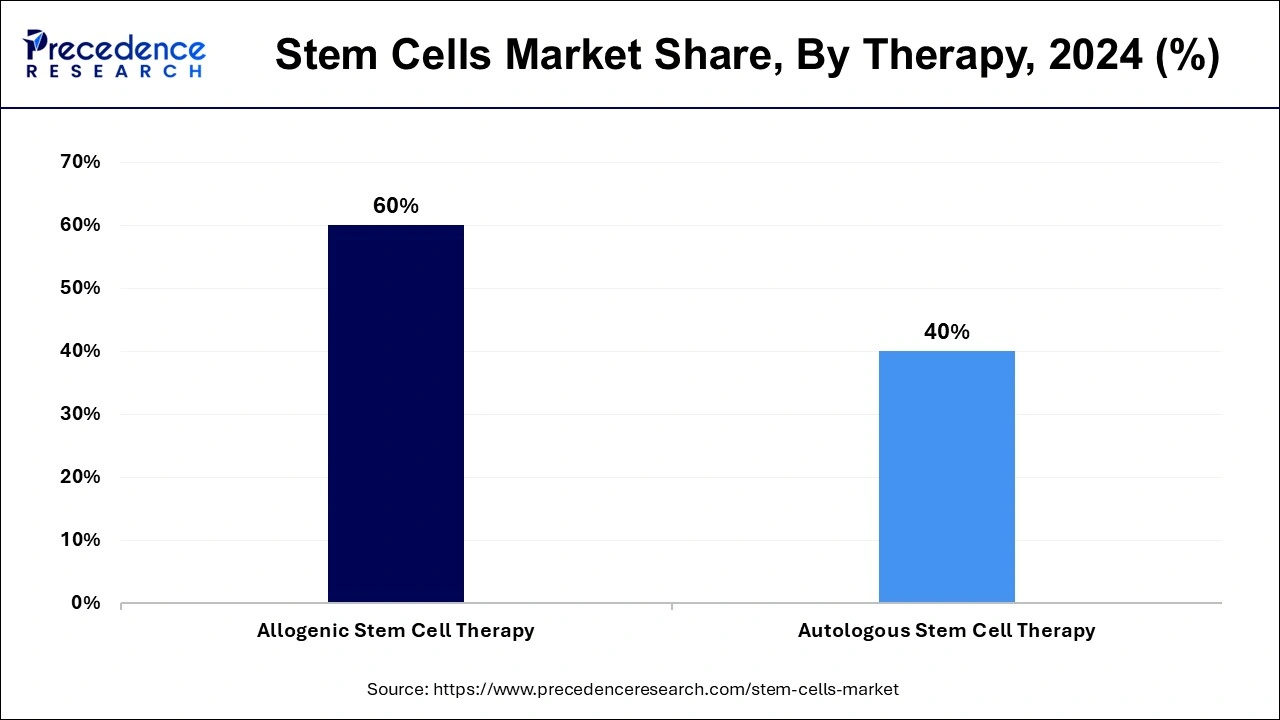
The autologous segment is expected to grow at robust growth rate over the forecast period owing to low risk associated with autologous therapy.Another major factor expected to fuel the growth include increased survival, affordability, reduced risk of graft-versus-host diseases and no requirement for recognition of HLA-matched donor.
Regional Insights
U.S. Stem Cells Market Size and Growth 2025 to 2034
The U.S. stem cells market size is calculated at USD 5.75 billion in 2025 and is predicted to be worth around USD 15.79 billion by 2034, at a CAGR of 11.90% from 2025 to 2034.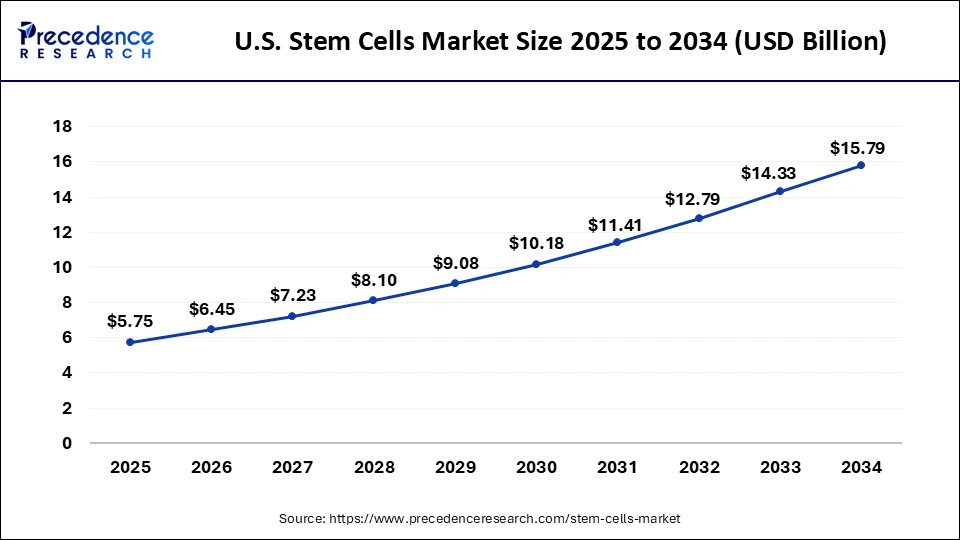
In 2024, North America led the stem cells market in terms of revenue owing to huge R&D investments in cytological research. The increased number of clinical trials undergoing in the U.S. also drives the market growth in this region. Stem cells are highly used in regenerative medicines particularly in the dermatology sector. The U.S. and Canada with their well-developed healthcare infrastructure will encourage research and development activities and emerging players.
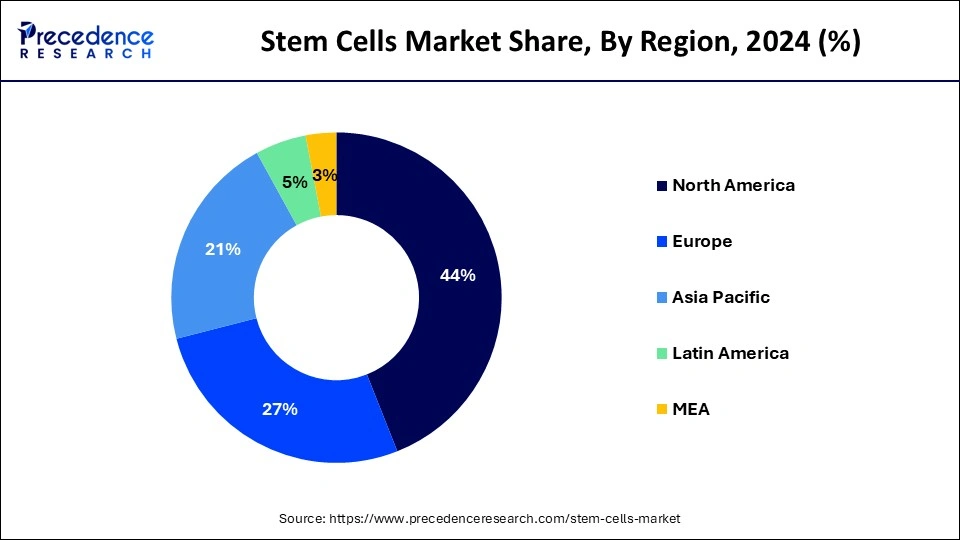
Stem cells market in Asia Pacific grows with the high CAGR on account of robust product pipelines in cell-based therapies and a huge patient pool.
Why Latin America is Noting the Growth of Stem Cells Market?
Latin America is an emerging but promising market. Leading urban centres São Paulo, Mexico City, Buenos Aires, and Santiago host advanced clinical centres capable of administering complex cell therapies and running trials. Challenges include constrained reimbursement, limited GMP manufacturing capacity in-region, regulatory heterogeneity, and cold-chain logistics across vast geographies. Opportunities lie in establishing regional CDMO hubs, technology transfer partnerships, and public-private initiatives to develop registries and outcome-tracking infrastructure. Tiered pricing strategies, capacity building for clinician training, and local cryobanks can accelerate access for patients in the region.
Brazil Stem Cells Market Trends
Brazil dominates the region with robust research institutions focusing on bone marrow and mesenchymal stem cell therapies. Mexico leverages its advanced healthcare infrastructure and proximity to the U.S. for cross-border clinical collaborations. Argentina emphasizes translational research and academic–industry synergy for neurological and cardiovascular applications. Chile invests in cell therapy innovation through public health-driven programs. Colombia is emerging as a hub for regenerative medicine clinics targeting orthopedic and dermatological treatments. Together, these nations reflect Latin America's gradual but strategic rise in the global stem cell ecosystem.
Can Middle East Africa Bridge Healthcare Gaps Through Regenerative Innovation?
The Middle East & Africa region is witnessing early but strategic movement toward integrating stem cell research into healthcare modernization. Governments are investing in biomedical R&D, focusing on chronic disease management and personalized medicine. Regional centers are being established for stem cell storage, bone marrow transplantation, and cell therapy research. Collaborations with Western biotech firms are accelerating access to advanced regenerative technologies. Ethical and legal frameworks are evolving to align with global standards while respecting local norms. Though still in early stages, the region's ambition to harness regenerative science for healthcare equity is unmistakable.
The UAE Stem Cells Market Trends
United Arab Emirates is leading the charge with dedicated stem cell research centers and government-backed healthcare innovation policies. Saudi Arabia invests heavily in biomedical R&D and translational programs through national vision initiatives. South Africa emphasizes cell-based therapies for hematological and autoimmune diseases. Egypt integrates academic research with clinical trials focusing on regenerative and fertility medicine.
Market Value Chain Analysis
- Raw Material Sourcing: Critical inputs include clinical-grade basal media, GMP cytokines and growth factors, animal-component-free supplements, viral vectors for engineered products, GMP-grade plastics and single-use bioreactors, vials and cryoprotectants DMSO alternatives emerging, and validated cell lines or donor tissues. Sourcing priorities are chain-of-custody, lot-to-lot consistency, regulatory compliance, and supplier qualification under GMP.
- Technological Advancements: Technological leaps central to commercialization include automated closed-system bioreactors enabling large-scale expansion, integrated single-use manufacturing lines, advanced cell-sorting and microfluidic-based separation, CRISPR and base-editing for precise cell engineering, and high-throughput potency and single-cell transcriptomic assays for product characterization.
Stem Cells Market Companies
- STEMCELL Technologies, Inc.
- Osiris Therapeutics, Inc.
- Cynata Therapeutics
- Human Longevity, Inc.
- Advanced Cell Technology, Inc.
- BIOTIME, Inc.
- Mesoblast Limited
- Promethera Biosciences S.A. / N.V.
- Merck Group
- Takara Bio Group
Segments Covered in the Report
By Product
- Adult Stem Cells
- Neuronal Stem Cells
- Mesenchymal Stem Cells
- Dental Stem Cells
- Umbilical Cord Stem Cells
- Adipose-derived Stem Cells
- HematopoieticStem Cells
- Dedifferentiated fat (DFAT) Cells
- Other ASC's
- Very Small Embryonic Like Stem Cells
- Human Embryonic Stem Cells
- Induced Pluripotent Stem Cells
By Application
- Regenerative Medicine
- Neurology
- Oncology
- Hematology
- Injuries
- Orthopedics
- Incontinence
- Diabetes
- Liver Disorder
- Others
- Drug Discovery and development
By Technology
- Cell Acquisition
- Apheresis
- Bone Marrow Harvest
- Umbilical Blood Cord
- Cryopreservation
- Cell production
- Therapeutic Cloning
- Cell Culture
- In-Vitro fertilization
- Isolation
- Expansion and Sub-Culture
By Therapy
- Allogenic Stem Cell Therapy
- Autologous Stem Cell Therapy
By Region
- North America
- Latin America
- Europe
- Asia-pacific
- Middle and East Africa
For inquiries regarding discounts, bulk purchases, or customization requests, please contact us at sales@precedenceresearch.com
Frequently Asked Questions
Ask For Sample
No cookie-cutter, only authentic analysis – take the 1st step to become a Precedence Research client
